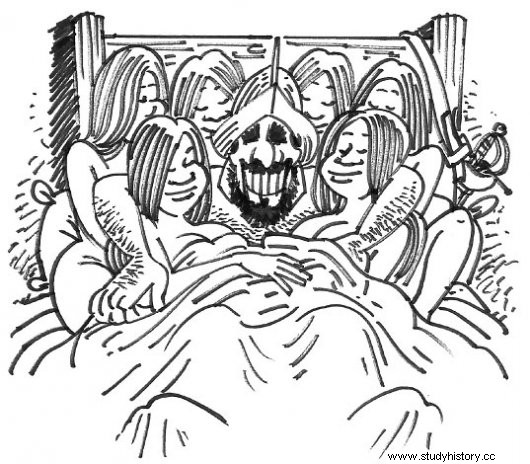The late incorporation of Spanish women to the American continent had a lot to do with the relations between Spaniards and indigenous people, and with the subsequent miscegenation. The Spanish equalized that numerical imbalance by “incorporating” indigenous women into their lives as wives, concubines, and even slaves. To address the legal vacuum that mixed relationships entailed, King Ferdinand the Catholic approved a Royal Decree in 1514 that validated any marriage between Castilian men and indigenous women, ensuring the absolute legitimacy and equality of the offspring that arose from mixed marriages compared to the marriages of Castile.
I am informed that one of the things that has altered the most on the island of Española and that has made us most at odds with the Indians has been taking their women...
Even so, and as could be deduced from the words of the monarch, abuses continued to be committed and although the Indian local authorities persecuted cohabitation, they turned a blind eye because on many occasions the governors themselves were the ones who practiced it. So, to avoid greater evils, by Royal Decree of August 21, 1526, King Carlos I granted license to Juan Sánchez Sarmiento to build a whorehouse in Santo Domingo...
for the honesty of the city, of married women and to avoid other damages and inconveniences, there is a need to make a house for public women

The irony is that in addition to the signature of the king, who granted the license, the document was signed by three bishops. Due to the proximity of the Santo Domingo brothel to the Dominican convent -I suppose because of blind eyes...-, in 1531 the Crown ordered the public women's house to be moved to another location. That same year, the same resolution was adopted in favor of Bartolomé Cornejo so that he would found the same type of establishment in Puerto Rico.
The reality is that the new expeditions and the discoveries of unknown territories repeated these abuses. Like what happened in Asunción (today the capital of Paraguay). In the territory occupied by the Carians (one of the groups that formed the Guarani ) along the Paraguay River, and on what was the military fort of Nuestra Señora de la Asunción , the city of Asunción was founded on September 16, 1541. Domingo Martínez de Irala , Governor of the Río de la Plata and Paraguay, decided to follow a very particular policy regarding concubinage and cohabitation with indigenous women. Not only did he live with several concubines from the beginning of the foundation of Asunción, but he also allowed and encouraged the rest of the Spaniards to also live with several Guarani women. Irala justified this permissiveness by saying that it was a way, in his opinion successful, to reach peace and forge alliances with the different indigenous groups. In the eyes of the Church that was an aberration and in 1545 the priest Francisco González Panigua he wrote a letter of protest to the king of Spain in which he recounted what was happening there...
…that the Christian who is happy with two Indian women is because there cannot be four, and the one who is happy with four because there cannot be eight. And so on the rest up to eighty, two and three if he is not some poor man; there is no one under five and six, most of fifteen and twenty, and thirty and forty the captains […] With such shamelessness and little fear of God that there is among us in being as we are with the Indian women who do not there is Mohammed's Alkoran that allows such shamelessness.
Father Rivadeneyra said, in a report sent to Spain, that Asunción was «called by the common people the Paradise of Muhammad » -I guess because of what they looked like Muslim harems-.
In another letter to the king by Alonso Riquelme , son-in-law of Irala, defended the policy of his father-in-law...
…they give us their daughters to serve us at home and in the fields, of whom and of us there are more than four hundred mestizos between males and females, so that your grace can see if we are good settlers, and not conquerors.
Consequently, this policy generated a large mestizo offspring that was the basis of the Creole race in that part of America. The daughters of Irala were given in marriage to different Spaniards also with the spirit of establishing alliances and balances between the different factions whose existence characterized the primitive Asunción. Irala's will, dated March 13, 1556, attested to his deeds…
I say and declare and confess that I have and God has given me in this province certain daughters and sons who are:Diego Martínez de Irala and Antonio de Irala and Mrs. Ginebra Martínez de Irala, my children, and María my servant, daughter of Pedro de Mendoza, a leading Indian who was from this land; and Doña Marina de Irala, daughter of Juana my servant; and Doña Isabel de Irala, daughter of Águeda, my servant; and Doña Úrsula de Irala, daughter of Leonor, my servant; and Martín Pérez de Irala, son of Escolástica, my maid; and Ana de Irala, daughter of Marina, my maid; and María, daughter of Beatriz, servant of Diego de Villalpando, and for being as I have them and I declare for my sons and daughters and portals I have married according to law and blessing, as the Holy Mother Church commands.
Sources:Women in Conquest and Muhammad's Paradise, Sex in the Conquest of America, Wherever Luck Takes You – Jose Luis Hernandez Garvi
